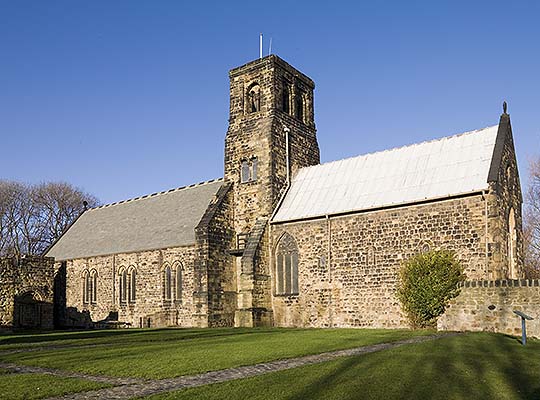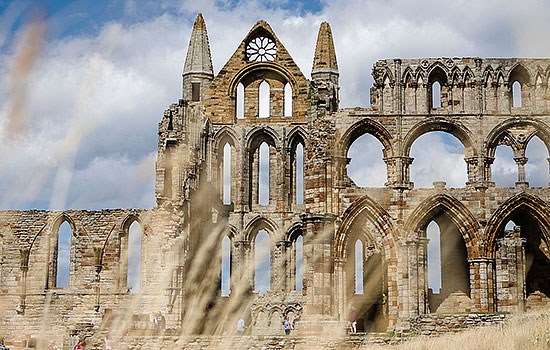History of St Paul’s Monastery, Jarrow
St Paul’s Monastery, with its twin, St Peter’s at Wearmouth, Sunderland, was one of Europe’s most influential centres of learning and culture in the 7th and 8th centuries. The remains standing today are from the medieval monastery, re-established in the 11th century. Part of the Anglo-Saxon monastery survives today, however, as the chancel of St Paul’s Church.

The Anglo-Saxon Monastery
Wearmouth–Jarrow was the creation of Northumbrian nobleman Benedict Biscop (about 628–90), who visited Rome and was inspired by the Christian life he saw there.
In 674 he approached King Ecgfrith of Northumbria for land for a monastery. He was first given a large estate to found St Peter’s, Wearmouth, and then in 681 received land at Jarrow to found St Paul’s. The twin monastery probably once owned much of the land between the rivers Tyne and Wear.
Biscop brought stonemasons and glaziers from France, who created some of the first stone buildings in Northumbria since the Roman period. Excavations have revealed that the earliest monastery had two churches, lying parallel to two large buildings, with a guesthouse close to the river.
It was not uncommon for Anglo-Saxon monasteries to have more than one church. The larger one may have served local people as well as the monks. The smaller church was perhaps reserved exclusively for monks, or may have been used as a funerary chapel.
Of the two other large buildings, one had settings in the floor that might have supported seating. Food debris such as fish bones was also found, suggesting that this was a refectory.
The other building contained a large, finely decorated room, probably used as a communal hall. In it was a central stone seat from which the abbot may have presided over meetings of the monks. Each building may have had an upper floor containing dormitories.
At the far left of this building was a suite of two rooms divided by a low screen. The finer room was perhaps an oratory, with an altar, and the other a living room.
The guesthouse by the riverside was finely decorated with painted plaster and coloured glass windows. Craft and industrial activity (such as metal- and glass-working) also took place on the riverside. There is evidence for terraced gardens on the south-facing slope towards the river, where vegetables and herbs were likely to have been grown.
The Venerable Bede
The monastery’s reputation spread throughout Europe, chiefly because of the scholarly writings of the Venerable Bede. Bede entered St Peter’s in about 680 at the age of seven, and spent his life in the twin monastery of Wearmouth–Jarrow, which he described as ‘one monastery in two places’.
Inspired by the scholarship and new style of monastic life here, he dedicated his life to study. He wrote more than 60 works, most notably the first history of the English, the Ecclesiastical History of the English People. He died in 735.
The Medieval Monastery
During the 9th century monastic life here declined, although the site may have remained a place of pilgrimage because of its association with Bede. In the 1020s some bones, thought to be Bede’s remains, were taken from here to Durham Cathedral.
The monastery was re-established in the 1070s by Aldwin, prior of Winchcombe in Gloucestershire, who was inspired by reading Bede’s Ecclesiastical History to visit the holy places of Northumbria.
With the permission of the Bishop of Durham, Aldwin began to rebuild the monastery. He introduced a Benedictine-style layout for the monastic buildings, based on a central cloister with an enclosed walkway where members of the community could spend time in prayer and contemplation.
Aldwin’s monastery was never completed, although it was used until the Suppression of the Monasteries on a much smaller scale than before.
The east range of the monastery was finished, but the south and west ranges were still being built when construction was interrupted in 1083. Aldwin was invited to become prior of Durham and the Wearmouth–Jarrow monks were relocated there to become the centre of the newly reformed monastic community.
By the 12th century, however, monastic life was re-established here as one of nine dependent cells of Durham. The religious community was very small: a master in charge of one or two monks, who were based here for only about three years before returning to Durham. At that time Jarrow was one of Durham’s poorest dependent cells.
The main monastic buildings were altered in the 13th and 14th centuries – new buildings were added in the south range and the cloister arcades were removed. The community functioned much like a manor house, supported by a home farm and lay servants. The wider estate included a barn, granary, buildings to house animals, and a windmill.
After the Suppression
After the priory was suppressed in 1537, the eastern part of the church remained in use as the parish church. The larger church was demolished and replaced in the 18th century, and was then rebuilt by George Gilbert Scott in the 1860s.
Between 1963 and 1978 the monastery was excavated extensively, and it is now one of the best understood Anglo-Saxon sites in England.
Further Reading
Cramp, R, Wearmouth and Jarrow Monastic Sites, Volumes 1 and 2 (English Heritage, Swindon, 2005)
McClure, J, Collins, R and Colgrave, B (eds), Bede’s ‘The Ecclesiastical History of the English People’ (Oxford, 1999)
Hunter Blair, P, The World of Bede (Cambridge, 1990)


